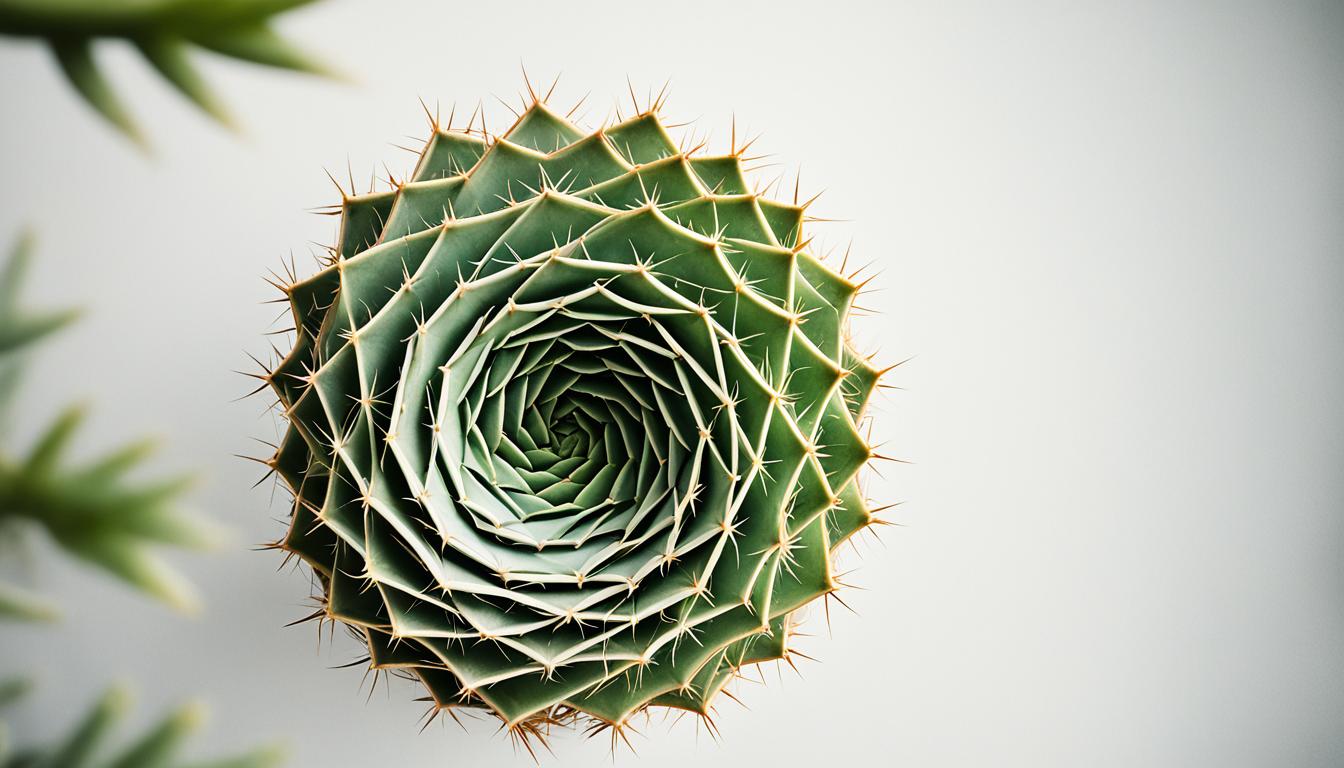Spiral cacti are great for indoor spaces like apartments. They look beautiful and have cool spirals. They are good for beginners or those who love plants a lot. This guide will help you grow and take care of them in your place.
Key Takeaways:
- Discover why spiral cacti are popular choices for apartment dwellers
- Learn about their air-purifying properties
- Find out if spiral cacti are pet-friendly
- Understand the size potential of these plants
- Gain insight into the essential steps for successful growth, including choosing the right pot and soil, providing adequate light, watering, fertilizing, pruning, and propagating
Why Do We Love the Spiral Cactus For Apartments?
The spiral cactus is a great indoor plant for your apartment. It brings unique beauty and has many benefits.
Is the Spiral Cactus Air-Purifying?
The spiral cactus cleans the air. It filters out toxins, making the air fresher.
It’s great for busy cities or just healthier living. This plant takes out bad pollutants.
Is the Spiral Cactus Pet Friendly?
Pets and the spiral cactus get along. It’s safe for cats and dogs.
It’s nice to have, but keep pets from eating it. This could upset their stomachs.
How Big Does the Spiral Cactus Get?
This cactus stays small, perfect for tight spaces. It grows 6-12 inches tall.
Put it on counters or windowsills. It adds greenery without taking much space.
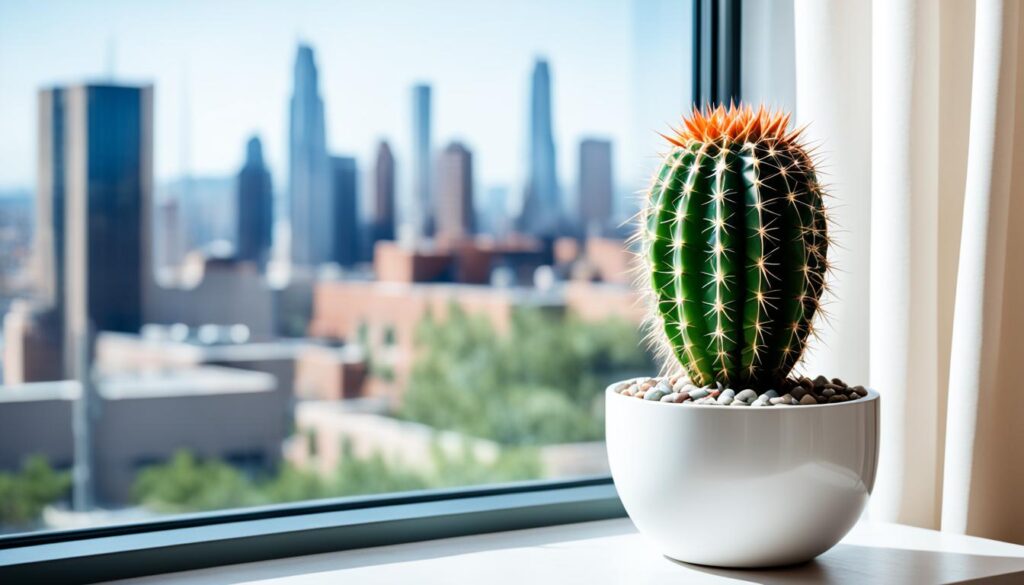
The spiral cactus is great for fresh air, pet lovers, or adding green without big size. It’s loved by apartment dwellers for these reasons.
How to Grow a Spiral Cactus – Learn to Grow this Indoor Beauty
Growing a spiral cactus is fun. It makes your home look beautiful. Let me show you how to grow and care for it. Your spiral cactus will love your home.
Choosing the Right Pot and Soil
It’s important to pick the right pot and soil. This helps your cactus grow well. Make sure your pot drains water so roots don’t rot. Use special cactus soil that drains well too. The best soil is a bit acidic, around 6.0 to 7.0.
Providing Adequate Light
Spiral cacti need lots of light but not too much sun. Put them near a sunny window. Too much direct sun can hurt the leaves. If there’s not enough sun, use a grow light.
Watering and Humidity
Water and humidity are key for your cactus. Let the soil dry a bit between watering. Then water it well. Don’t water too much. This can cause root rot. Cacti like dry air. You can use a water tray or humidifier to help.
Nutrition and Fertilization
Feed your cactus in spring and summer. Use half-strength cactus fertilizer. Do this every few weeks. In fall and winter, cacti rest. So, you can stop feeding them.
Pruning and Maintenance
Keep your cactus looking good by trimming it. Cut off any bad parts with clean shears. Check for bugs or disease. Clean leaves help the cactus stay healthy.
Propagation
You can make more cacti from yours. Use stem cuttings or divide the plant. Let cuttings dry, then plant in cactus soil. Keep it moist until it grows roots.
Monitoring for Pests and Diseases
Watch your cactus for bugs or sick parts. If you see bugs, clean them off with alcohol. If it looks sick, take care of it right away. This keeps your cactus healthy.
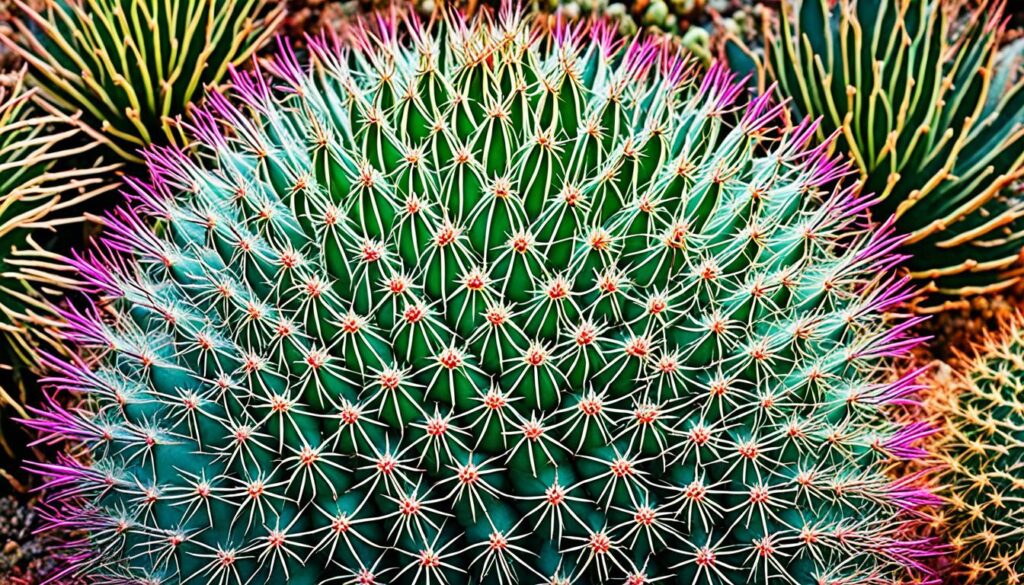
| Aspect | Preferences |
|---|---|
| Light | Bright, indirect light |
| Watering | Allow soil to dry out between waterings |
| Humidity | Low to moderate humidity levels |
| Soil | Well-draining cactus mix |
| Fertilization | Balanced cactus fertilizer during spring and summer |
| Pruning | Remove dead or damaged foliage |
| Propagation | Stem cuttings or division |
| Pests and Diseases | Monitor regularly and treat promptly |
Appearance of Spiral Cactus
In this section, let’s look closer at the spiral cactus’s unique look. This cactus, called the Senecio Spiral or Succulent Spiral, has a cool shape. It’s different from other cacti.
“The spiral cactus is a natural artwork. Its leaves grow tight and up, making a cool spiral. It looks like a coiled stairway. The stem twists, showing a beautiful natural pattern.”
The more it grows, the more the spiral cactus twists and turns. This makes it look even cooler. The plant gets lots of spirals that look amazing together. Each spiral tells a bit of the plant’s life story.
The spiral cactus can be many colors, which makes it even more pretty. Green is usual, but some are blue, silver, or purple. These colors make the plant look great in any room.
This cactus catches everyone’s eye no matter where you put it. It can be on a windowsill, a table, or in a big succulent garden. People always stop to look and talk about it.

We’ve now seen how stunning the spiral cactus is. Next, we’ll check out what kind of light these special plants need.
Light Requirements for Spiral Cactus
Light is very important for spiral cacti. They need certain light to grow and stay spiral. We will talk about what light they need. This info will help you take good care of them.
Spiral cacti need the right amount of sun. They grow well with some sunlight. But some shade is okay too. This helps them grow their best.
Put your cactus near a window for more light. A window facing south is good. If your plant stretches too much, it needs more sun.
But very strong sun in summer is bad. It can hurt your cactus. So, give it some shade when the sun is too hot. Find a good mix of sun and shade for a happy cactus.
Good light makes spiral cacti look amazing. Their spiral shape looks cool in light and shadow. Good light makes sure they grow and look beautiful.

Keep checking the light for your spiral cacti. A mix of sun and shade is best. This helps them be healthy and beautify your home.
Watering Requirements of the Spiral Cactus
Water is key for your spiral cactus to be healthy. I will show you how to water them right. It is crucial to know when and how much to water. This will keep your spiral cactus happy.
Signs of Overwatering vs. Underwatering
Too much or too little water is bad. It can hurt your spiral cactus. Knowing the signs will help you avoid damage. This way, your plant gets just the right amount of water.
If you water too much, your cactus could get sick. Look out for these signs of too much water:
- Yellowing or wilting of the leaves
- Mushy or soft stems
- Foul odor coming from the soil
- Pale or transparent leaves
- Excessive drooping or sagging of the plant
Not enough water makes the cactus dry and small. Here are signs it needs more water:
- Wrinkled or shriveled appearance of the plant
- Drooping or wilting leaves
- Brown, dry, or crispy leaves
- Yellowing or browning of the tips of the plant
- Slow growth or stunted development
Sometimes, these signs mean other problems too. It could be the light or how warm it is. So, think about all things when you check your cactus.
Fertilizing a Spiral Cactus
Fertilizing spiral cacti is key to their health. It helps them grow well. I will show you how to fertilize them right. We will also talk about the best food for these plants.
Recommended Fertilizer for a Spiral Cactus
It’s important to pick the right food for your cactus. Choose one with low nitrogen. High nitrogen can make your plant weak. Instead, look for food high in phosphorus and potassium. These help the roots and make the plant strong.
A great choice is a special cactus and succulent food. This kind of food meets a cactus’s needs well. Find a food that has a 2:1:2 or 3:1:2 mix for the best results.
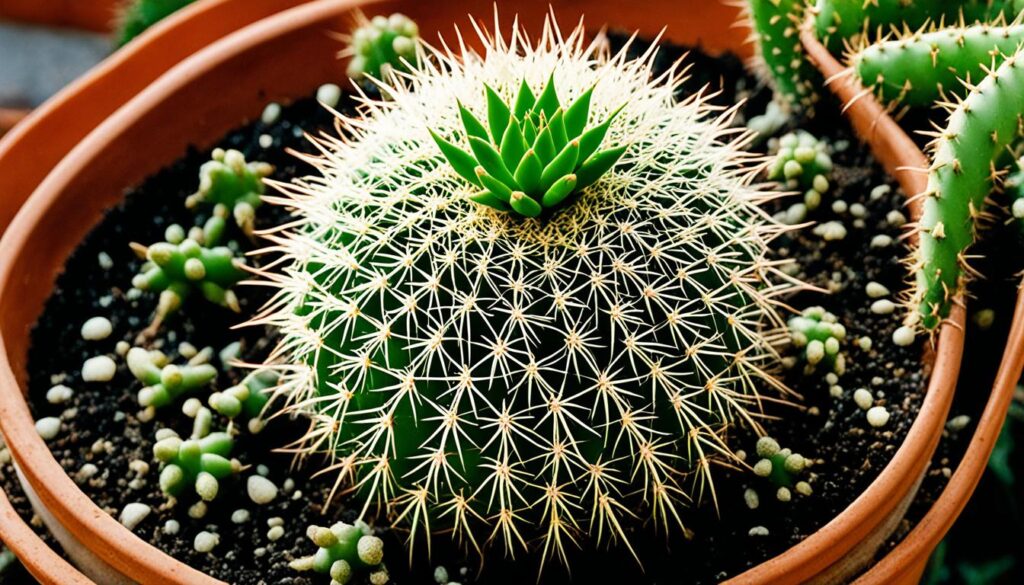
Always follow the food’s instructions. Don’t use too much. You can feed your cactus every three to four weeks when it’s growing. This is usually in spring and summer. Don’t feed it in winter when it rests.
| Fertilizer | Ratio (NPK) | Application Frequency |
|---|---|---|
| Cactus and succulent fertilizer | 2:1:2 or 3:1:2 | Every 3-4 weeks during the growing season |
Make sure the soil is wet before you feed your plant. Mix the food with water as the package says. Then water your cactus like you usually do. Never feed it when the soil is dry. That could hurt the roots.
Picking the right food and using it right helps your cactus. It will grow strong and keep its cool spiral shape. This makes it a beautiful indoor plant. Watch how your cactus reacts to the food. You might need to change how often or how much you use. With the right care, your spiral cactus will be healthy and happy.
Potting a Spiral Cactus
Getting the potting right is key for a happy spiral cactus. I’ll show you how to pick the best pot and soil. Also, I’ll tell you when and how to repot it.
Choosing the Right Pot Size
Picking the right pot size is very important. The pot should be a bit bigger than the cactus itself. Choosing a pot that encourages proper growth not only provides ample space for root development but also helps with drainage. To ensure your cactus thrives, it’s essential to follow some brazilian cactus care tips, such as using a well-draining soil mix and placing the pot in a location that receives plenty of sunlight. Remember, too large of a pot can lead to overwatering, which is detrimental to these hardy plants.
This lets the roots grow but keeps them snug. A too big pot can harm the plant.
Using the Right Potting Mix for a Spiral Cactus
The best soil mix is critical for your cactus. It needs to drain well but stay moist.
Use cactus mix, perlite, and sand. This mix keeps your plant healthy and fed.
Repotting When Necessary
Sometimes, your cactus needs a new home. Repotting helps it keep growing well.
Look for tight roots or a heavy top. Also, if the soil gets hard, it’s time to repot.
Be gentle when moving the cactus. Check the roots and trim any bad parts. Then, use new soil in a bigger pot.
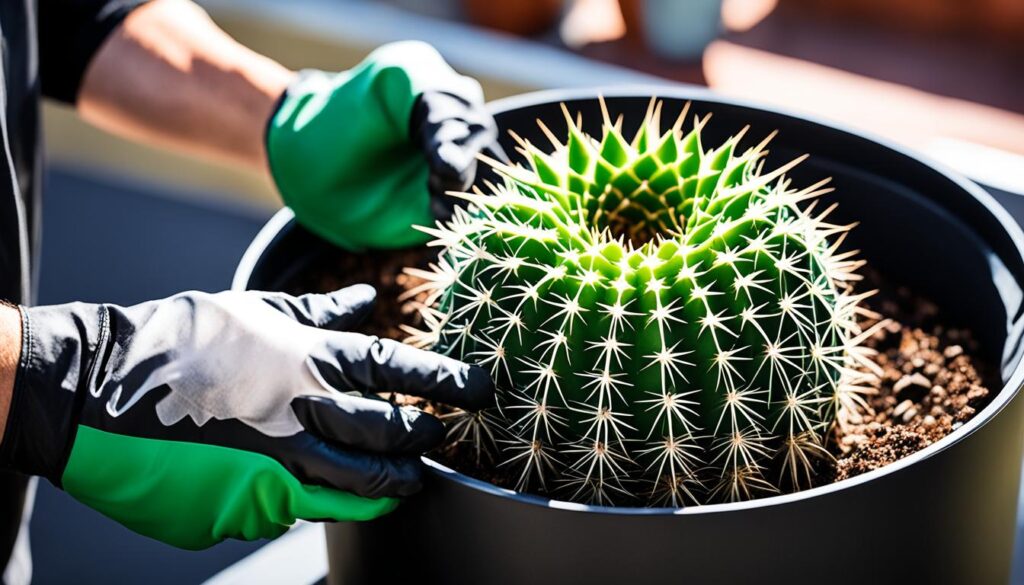
| Pot Size | Ideal Plant Size |
|---|---|
| 4 inches | Small to medium-sized spiral cacti |
| 6 inches | Larger spiral cacti |
| 8 inches | Very large spiral cacti |
Propagating a Spiral Cactus
Propagating spiral cacti is a fun way to grow your collection. You can share these special plants with friends. You can use stem cuttings or seeds to do this. Each way has good points and things to think about. Let’s look into them more.
Stem Cuttings or Seeds?
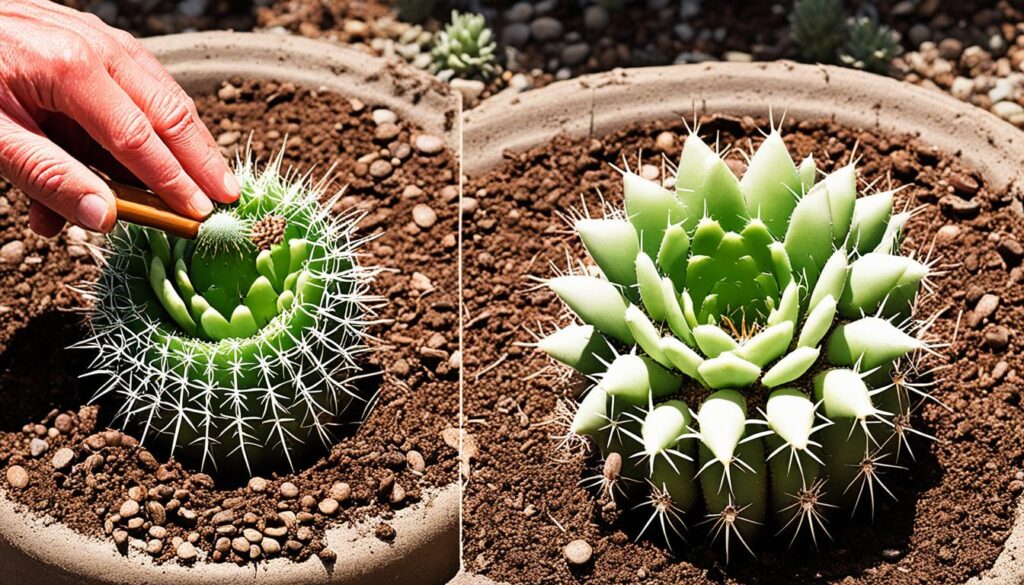
Stem cuttings are a great way to make more spiral cacti. Here’s how to use stem cuttings:
- Find a healthy, big spiral cactus.
- Cut a good stem piece with a clean knife or scissors.
- Let the cut dry for some days to stop rot.
- Stick the stem cutting in soil that drains well, about an inch in.
- Put it where it’s bright but not in direct sun.
- Be careful with water. Let the soil get dry before watering again.
- Take care of it, and it will grow roots and become a new plant.
Seeds are another way to grow spiral cacti, but it takes longer. Here’s the seed method:
- Get fresh seeds from a good place.
- Use a tray or pots with the right cactus soil.
- Put the seeds on the soil and press them down a bit.
- Spray water on the soil to dampen it.
- Cover with plastic to keep moisture in, like a tiny greenhouse.
- Keep them warm and out of direct sun.
- Water just enough to keep the soil moist.
- In a few weeks, tiny plants will start to grow.
- As they grow, give them more light and get them used to indoors.
Division of a Spiral Cactus
Breaking a spiral cactus into parts is another way to make new plants. Here’s how to divide a spiral cactus:
- Pick a big spiral cactus with many stems.
- Take it out of its pot and separate the stems gently.
- Make sure each piece has roots.
- Plant each piece in its own pot with good soil.
- Look after them with enough light and water.
Propagating makes more spiral cacti to enjoy and share. You can try stem cuttings, seeds, or dividing the plant. Each way has its own fun parts and gifts. Try different ways to see what’s best for you. Have fun growing new spiral cacti.
Growth and Development of the Spiral Cactus
It’s important to know how spiral cacti grow and develop. This helps us take good care of them. From tiny seeds to big plants, every step is key for their health and looks.
Many things affect how spiral cacti grow. This includes light, warmth, and water. They do best in bright, not direct sunlight. They like it when it’s between 60°F to 80°F (15°C to 27°C).
Make sure they get the right amount of water. Let the soil dry before watering again. This stops root rot.
Your spiral cactus will change as it grows. Its spiral shape will get clearer and more detailed. Its spines also grow and help keep it safe. They make the cactus look special, too.

To keep your spiral cactus healthy, give it what it needs. This means enough light, the right temperature, and water on a schedule. Using fertilizer helps it grow strong and beautiful.
If you take good care of your spiral cactus, it will grow well. Enjoy its lovely spiral shape. Watch it become an amazing focal point in your home.
Dealing with Pests and Diseases in the Spiral Cactus
Spiral cacti can get sick or face bug problems, just like other plants. We’ll show you how to find and fix these issues. It’s important to act early to keep your spiral cactus healthy.
Bugs like spider mites, mealybugs, and scale insects can harm your cactus. They can damage leaves, slow growth, and make the plant weak. Look for webbing, sticky stuff, or tiny bugs to catch these pests early.
“Regularly inspecting your spiral cactus for signs of infestation will help you detect and address any pest problems early on.”
To stop diseases, your spiral cactus needs the right care. Use well-draining soil and water correctly to avoid root rot. Make sure the soil dries before you water again.

There are ways to treat pests or diseases on your cactus. For small bug problems, use a cotton swab with rubbing alcohol or insecticidal soap. These methods are safe for the plant.
If the problem is big, you might need chemicals. But, be careful with pesticides. Always follow the instructions. You can also try natural helpers like ladybugs.
| Pests | Symptoms | Treatment |
|---|---|---|
| Spider Mites | Webbing, yellowing leaves, stippling | Manually remove with alcohol-soaked cotton swabs or use insecticidal soap |
| Mealybugs | White, cotton-like clusters on stems and leaves | Remove with alcohol-soaked cotton swabs or use insecticidal soap |
| Scale Insects | Small, oval-shaped bumps on stems and leaves | Manually remove with alcohol-soaked cotton swabs or use insecticidal soap |
Keep an eye on your cactus and act fast if you see problems. This way, your plant will stay healthy and beautiful.
Common Spiral Cactus Pests
In this section, you’ll learn about spiral cactus pests. Knowing them helps you catch and fix problems fast.
1. Spider Mites
Spider mites are tiny bugs that harm spiral cacti. They like dry, warm places.
To fight them, clean the leaves with a damp cloth. Or use bug-killing soap.
2. Mealybugs
Mealybugs look small, white, and fluffy. They harm the cactus by eating its sap.
Use a cotton swab with alcohol to pick them off. Or, try neem oil.
3. Scale Insects
Scale insects are flat and stick to cactus parts. They make the plant sick.
Brush them off or use plant oil to beat them.
4. Aphids
Aphids are tiny bugs that damage spiral cacti. They make growth weird and leaves curl.
Wash them off with water or use bug-killing soap.
5. Thrips
Thrips are small, narrow bugs that harm the cactus. They cause leaves to look weird.
Remove sick parts or trap them with sticky traps.
6. Fungus Gnats
Fungus gnats are like tiny mosquitoes. Their babies eat cactus roots, hurting the plant.
Let soil dry or use sticky traps for adults.
Natural Predators
To manage pests on your spiral cactus, think about using natural predators. Beneficial insects are key in controlling pest numbers. They offer a safe and effective way to keep your garden healthy. This reduces the need for harmful chemicals.
Isolate Infected Plants
If pests infest your plants, keep them away from healthy ones. This stops pests from spreading. It also keeps your other plants safe. By isolating sick plants, you protect your whole spiral cactus collection.
Chemical Treatment
Sometimes, chemicals are needed to fight off pests. But be careful and use them wisely. Always stick to safety rules when spraying pesticides. Use the right amount to avoid hurting your plants or the earth. Consider chemicals only if nothing else works.
Disease Prevention For Spiral Cacti
Keeping spiral cacti healthy is very important. With the right care, you can lower disease risks. This makes your plants happier and healthier. Let’s talk about how to keep your spiral cacti safe from disease:
- Proper sanitation: Make sure your cacti are clean. Get rid of dead stuff in the soil or near your plant. This stops bad germs from growing. It keeps your cacti in good shape.
- Maintaining optimal growing conditions: Spiral cacti like dry soil that drains well. Make sure they’re in the right soil and don’t water them too much. The right amount of light, warmth, and moisture helps them stay strong.
- Avoiding common disease triggers: Some things make cacti get sick more easily. Try not to stress your plants with big temperature changes, too much fertilizer, or putting too many together. Good air flow around your cacti stops fungus from growing.
By using these tips, your spiral cacti can be healthy and beautiful. Taking steps to prevent disease keeps your plants safe. It also makes them look better and live longer.
Tips for Maintaining Spiral Cacti
To keep your spiral cacti healthy, follow these tips. This will help them grow well.
Wiping Leaves
Wiping your cacti’s leaves is key. Dust blocks sunlight, making it hard for them to breathe. Use a soft cloth to gently clean the leaves. This keeps them healthy and nice.
Outdoor Exposure
Spiral cacti like being indoors but also enjoy the outdoors. Being outside gives them sunlight and fresh air. This makes them strong and happy. But, start slow to avoid harm. Begin with short outside times, then slowly add more.
Adjusting Watering Schedule
Change how often you water your cacti with the seasons. They need more water when it’s warm and growing. They need less when it’s cold. Watch your plant and soil to water just right.
Following these tips helps your spiral cacti stay healthy and bright. Wipe leaves, give them outdoor time, and water correctly for their needs. Doing this will let you enjoy your beautiful cacti for many years.
Tips for Successful Overwintering of Spiral Cactus
Keeping spiral cacti alive in cold weather can be hard. But with the right advice, you can keep them safe. Here are some tips to help your spiral cactus during winter:
1. Maintain Ideal Temperature Ranges: Keep your cactus away from very cold temperatures. Make sure they stay warm, between 50°F and 60°F. Don’t put them near drafty spots.
2. Provide Adequate Light: Spiral cacti need some light in winter. Put them near a window that gets a lot of sun. Use a grow light if you need more light.
3. Protect from Cold and Frost: Cold and frost can hurt spiral cacti. If it gets too cold, cover them or bring them inside.
4. Limit Watering: Cacti drink less water in winter. Only water when the soil is dry. Be careful not to water them too much.
5. Avoid Fertilizing: Don’t give your cactus food in winter. They need to rest. Start feeding them again in spring.
6. Inspect for Pests: Check your cactus for bugs like mealybugs. If you find bugs, get rid of them quickly.
Follow these tips to help your spiral cacti survive the winter. With the right care, they will keep looking beautiful all year.
Growing Spiral Cactus from Seed
Growing spiral cacti from seed is rewarding. I will show you how to start them from seed. By following these steps, you can watch them grow from seed to mature cacti.
Seed Preparation:
- First, choose high-quality seeds. You can buy them online or at plant nurseries.
- Soak the seeds in warm water for 24 hours. This makes the seed coat soft. It helps them germinate well.
Germination Techniques:
- Pick a small container with holes for drainage. Fill it with cactus mix.
- Wet the mix until it’s damp but not wet. Too much water can rot seeds.
- Put the seeds on the mix, spread out. Press them in so they touch the mix.
- Cover the seeds with a little mix, about 1/4 inch deep.
- Keep the container in a warm, bright spot but out of direct sunlight. They need warmth, around 70-80°F (21-27°C).
- Keep the mix moist but not wet. Water from below to avoid too much moisture.
- Seeds should start growing in 2-4 weeks. This can change with different cactus types.
Care for Young Seedlings:
- When seedlings show up, they need light. Start with a bit of sun and add more slowly. This helps them not get sunburned.
- Keep the mix moist, but not too wet. Let the top dry a bit between watering.
- Once they’re big enough, move them to their own pots with cactus mix.
- Watch for pests or diseases. If you see any, deal with them quickly.
By following these steps, you can grow your own spiral cacti from seeds. Enjoy watching your tiny seeds grow into beautiful plants.
Varieties of Spiral Cactus
Spiral cacti come in many varieties. Each one has its own look and way to grow. This part will tell you about some popular types. We will look at what makes each special and how to care for them. You’ll learn about many options in spiral cacti.
The Echinopsis spachiana is known as “Golden Torch” or “Golden Flame.” It has bright yellow or golden spines that spiral up. It looks stunning. This cactus loves bright light and needs soil that drains well. It’s a great choice for growing in an apartment.
The Stenocactus crispatus is called the “Brain Cactus.” It looks like it has a brain because of its ribbed look. The ribs make interesting spiral patterns. This plant does well in bright, indirect light. It also doesn’t need much water, so it’s easy to keep.
The Ferocactus latispinus is also known as “Devil’s Tongue” or “Barrel Cactus.” It has spiraling ribs with bright red or orange spines. These add a big pop of color where you put it. It likes lots of sun and soil that drains well. You can grow it inside or outside.
FAQ
Q: Why do people love the spiral cactus for apartments?
A: People love it because it’s beautiful. It also cleans the air.
Q: Is the spiral cactus air-purifying?
A: Yes, it cleans the air. That makes it great for inside your home.
Q: Is the spiral cactus pet-friendly?
A: Yes, it’s safe for pets. But watch how your pets are with it.
Q: How big does the spiral cactus get?
A: It depends on the type. But they’re usually small, perfect for small spaces.
Q: How do I choose the right pot and soil for my spiral cactus?
A: Pick a pot with holes at the bottom. Use soil that drains well.
Q: How do I provide adequate light for my spiral cactus?
A: They need bright, indirect sun. Put them near a window or use grow lights.
Q: How often should I water my spiral cactus?
A: Water when the soil’s top inch is dry. Don’t let it stay wet.
Q: How do I fertilize my spiral cactus?
A: Use balanced fertilizer in spring and summer. Don’t fertilize in fall and winter.
Q: How do I pot my spiral cactus?
A: Choose a slightly bigger pot. It should have holes. Use special cactus soil.
Q: How do I propagate my spiral cactus?
A: You can use cuttings or seeds. Put cuttings in soil. Seeds need moist cactus mix.
Q: How can I prevent pests and diseases in my spiral cactus?
A: Keep your plant clean and healthy. Check it often. Deal with problems fast.
Q: What are the common pests that affect spiral cacti?
A: Watch out for mealybugs, spider mites, and aphids. Check often to fight them.
Q: Are there natural predators that can help control pests on my spiral cactus?
A: Ladybugs and lacewings help fight pests. Keep sick plants away from healthy ones.
Q: How can I prevent diseases in my spiral cactus?
A: Remove bad plant parts. Water correctly. Guard against cold and hot extremes.
Q: What are some tips for maintaining spiral cacti?
A: Clean leaves, give them outside time, and change water as needed.
Q: How can I successfully overwinter my spiral cactus?
A: Keep it warm and bright in winter. Protect it from cold and frost.
Q: How do I grow spiral cacti from seed?
A: Soak seeds, then plant in good soil. Keep warm and moist for germination.
Q: What are some popular varieties of spiral cacti?
A: Check out golden barrel, blue spiral, and fishhook cacti. Each is special.

